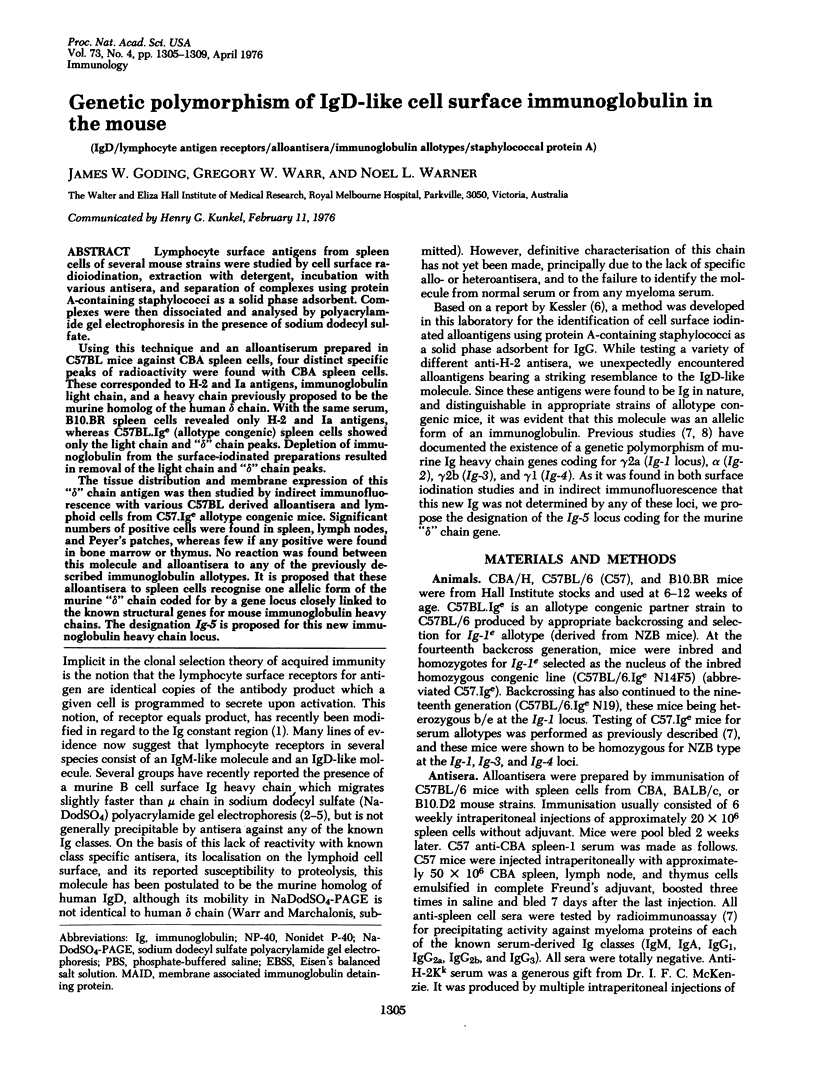Genetic polymorphism of IgD-like cell surface immunoglobulin in the mouse (original) (raw)
Abstract
Lymphocyte surface antigens from spleen cells of several mouse strains were studied by cell surface radioiodination, extraction with detergent incubation with various antisera, and separation of complexes using protein A-containing staphylococci as a solid phase adsorbent. Complexes were then dissociated and analyzed by polyacrylamide gel electrophoresis in the presence of sodium diodecyl sulfate. Using this technique and an alloantiserum prepared in C57BL mice against CBA spleen cells, four distinct specific peaks of radioactivity were found with CBA spleen cells. These corresponded to H-2 and Ia antigens, immunoglobulin light chain, and a heavy chain previously proposed to be the murine homolog of the human delta chain. With the same serum, B10.BR spleen cells revealed only H-2 and Ia antigens, whereas C57BL.Ige (allotype congenic) spleen cells showed only the light chain and "delta" chain peaks. Depletion of immunoglobulin from the surface-iodinated preparations resulted in removal of the light chain and "delta" chain peaks. The tissue distribution and membrane expression of this "delta" chain antigen was then studied by indirect immunofluorescence with various C57BL derived alloantisera and lymphoid cells from C57.Ige allotype congenic mice. Significant numbers of positive cells were found in spleen, lymph nodes, and Peyer's patches, whereas few if any positive were found in bone marrow or thymus. No reaction was found between this molecule and alloantisera to any of the previously described immunoglobulin allotypes. It is proposed that these alloantisera to spleen cells recognise one allelic form of the murine "delta" chain coded for by a gene locus closely linked to the known structural genes for mouse immunoglobulin heavy chains. The designation Ig-5 is proposed for this new immunoglobulin heavy chain locus.

Selected References
These references are in PubMed. This may not be the complete list of references from this article.
- Abney E. R., Parkhouse R. M. Candidate for immunoglobulin D present on murine B lymphocytes. Nature. 1974 Dec 13;252(5484):600–602. doi: 10.1038/252600a0. [DOI] [PubMed] [Google Scholar]
- Factors influencing the isolation of membrane immunoglobulins from T and B lymphocytes. 1. Detergent effects and iodination conditions. J Immunol. 1976 Mar;116(3):847–853. [PubMed] [Google Scholar]
- Goding J. W., White E., Marchalonis J. J. Partial characterisation of Ia antigens on murine thymocytes. Nature. 1975 Sep 18;257(5523):230–231. doi: 10.1038/257230a0. [DOI] [PubMed] [Google Scholar]
- Haustein D., Goding J. W. Surface immunoglobulin heavy chains of murine splenocytes and thymocytes are different. Biochem Biophys Res Commun. 1975 Jul 22;65(2):483–489. doi: 10.1016/s0006-291x(75)80173-2. [DOI] [PubMed] [Google Scholar]
- Haustein D., Marchalonis J. J., Harris A. W. Immunoglobulin of T lymphoma cells. Biosynthesis, surface representation, and partial characterization. Biochemistry. 1975 May 6;14(9):1826–1834. doi: 10.1021/bi00680a004. [DOI] [PubMed] [Google Scholar]
- Kessler S. W. Rapid isolation of antigens from cells with a staphylococcal protein A-antibody adsorbent: parameters of the interaction of antibody-antigen complexes with protein A. J Immunol. 1975 Dec;115(6):1617–1624. [PubMed] [Google Scholar]
- Lisowska-Bernstein B., Rinuy A., Vassalli P. Absence of detectable IgM in enzymatically or biosynthetically labeled thymus-derived lymphocytes. Proc Natl Acad Sci U S A. 1973 Oct;70(10):2879–2883. doi: 10.1073/pnas.70.10.2879. [DOI] [PMC free article] [PubMed] [Google Scholar]
- Premkumar E., Potter M., Singer P. A., Sklar M. D. Synthesis, surface deposition, and secretion of immunoglobulins by Abelson virus-transformed lymphosarcoma cell lines. Cell. 1975 Oct;6(2):149–159. doi: 10.1016/0092-8674(75)90005-7. [DOI] [PubMed] [Google Scholar]
- Vitetta E. S., Uhr J. W. Immunoglobulin-receptors revisited. Science. 1975 Sep 19;189(4207):964–969. doi: 10.1126/science.1083069. [DOI] [PubMed] [Google Scholar]